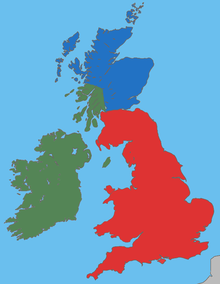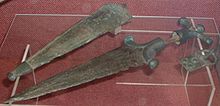
Back Celtiaid Ynysig CY Celtas insulares Spanish Liste des peuples celtes de Grande-Bretagne French Ceiltigh na nOileán GA Celtas insulares Portuguese
This article needs additional citations for verification. (June 2021) |


The Insular Celts were speakers of the Insular Celtic languages in the British Isles and Brittany. The term is mostly used for the Celtic peoples of the isles up until the early Middle Ages, covering the British–Irish Iron Age, Roman Britain and Sub-Roman Britain. They included the Celtic Britons, the Picts, and the Gaels.
The Insular Celtic languages spread throughout the islands during the Bronze Age or early Iron Age. They are made up of two major groups: Brittonic in the east and Goidelic in the west. While there are records of Continental Celtic languages from the sixth century BC, allowing a confident reconstruction of Proto-Celtic, Insular Celtic languages became attested only during the early first millennium AD. The Insular Celts followed an Ancient Celtic religion overseen by druids. Some of the southern British tribes had strong links with mainland Europe, especially Gaul and Belgica, and minted their own coins.
The Roman Empire conquered most of Britain in the 1st century AD, and a Romano-British culture emerged in the southeast. The Britons and Picts in the north, and the Gaels of Ireland, remained outside the empire. During the end of Roman rule in Britain in the 400s, there was significant Anglo-Saxon settlement of eastern and southern Britain, and some Gaelic settlement of its western coast. During this time, some Britons migrated to the Armorican peninsula, where their culture became dominant. Meanwhile, much of northern Britain (Scotland) became Gaelic.
By the 10th century, the Insular Celts had diversified into the Brittonic-speaking Welsh (in Wales), Cornish (in Cornwall), Bretons (in Brittany) and Cumbrians (in the Old North); and the Goidelic-speaking Irish (in Ireland), Scots (in Scotland) and Manx (on the Isle of Man). in southern Scotland and northern England, and the remnants of the Pictish people in northern Scotland.